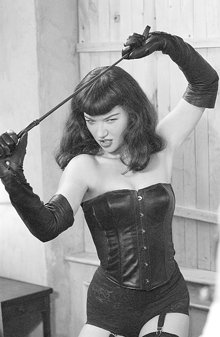The complex and irreconcilable Bettie Page
“The Notorious Bettie Page” features a great protagonist, even if it’s unsure what to do with her. The life of Bettie Page reveals some of the contradictions of her times—this film focuses on the ‘50s, when she worked as a pin-up model—and ours. Utopian thinking has fallen out of fashion, but in its own modest way, “The Notorious Bettie Page” practices it. It imagines a reconciliation between sex and religion. Admittedly, it’s a troubled one that requires a great deal of naiveté to work, but its awkwardness is still revealing.
Bettie Page (Gretchen Mol) grew up in Tennessee and came to New York in 1949. Following an abusive marriage and a gang rape, she sought a new start. Walking on the beach at Coney Island, she met off-duty cop and part-time photographer Jerry Tibbs (Kevin Carroll). She agreed to pose for him on the spot, gaining entry into a world of camera clubs. She soon became a favorite of photographers who freelance for men’s magazines and collectors. At the same time, she tried pursuing an acting career, taking classes and attending auditions. She found far more work as a model and was willing to appear both nude and in bondage. “The Notorious Bettie Page” tells her story in chronological order, interrupted by scenes of a 1955 Senate hearing on pornography.
Mol’s version of Page feels more like a fictional construct than a real woman, even if she’s based on one. Like Marilyn Monroe or Jayne Mansfield, there’s something hyperbolic about her—even her protective detachment seems exaggerated beyond reason.
In the ’50s, it was impossible for a woman to be both innocent and sexual. I’m not sure that the present day is much better. In a climate where a TV network gets fined for showing pixelated breasts, Page’s story retains its political impact. In her very persona, she reflected the schizophrenia of a culture in which pornography and fundamentalist religion held equal sway. These contradictions have yet to be settled. However, Page’s story is also a product of the ‘50s. It would have gone very differently had she taken responsibility for her desires or claimed authorship over her image. Before feminism and the sexual revolution, she had to remain shallow as a defense mechanism.
The film’s Page seems unreal partially because she rarely acknowledges her own sexuality. Unashamed of her body and willing to doff her clothes at the slightest pretense, she keeps her sex life and even her relationship with her boyfriend private. There’s something childlike, even pre-sexual about her poses. However, she enacts them with an enthusiasm that’s hard to fake. In her heart, that joy may have had more to do with acting than bondage, but most present-day porn performers are obviously going through the motions, enacting someone else’s fantasies. Page made you believe she really was turned on by the silly whip-and-high heels scenarios.
The structure of “The Notorious Bettie Page” doesn’t really suit her individual life story. The framing device of the Senate hearing makes her seem like a First Amendment martyr, but the point could have been made just as well without it, since she winds up not having to testify. Although the biopic formula calls for a dramatic redemption and Harron and Guinevere Turner’s script delivers one, Page never sinks to the depths that would require it. A few people say hurtful things to her; at worst, a man suggests that his son died trying to copy her bondage poses. In her modeling career, she’s never sexually degraded—the photographers keep their hands off her and don’t even come on to her verbally. The mainstream film industry is depicted as sleazier than the pin-up world. Even rape doesn’t seem to have any long-term impact on her. All through this period, she never gave up her religious faith.
Something about Page remains elusive. Harron adeptly apes various ‘50s styles—an early scene set in a newsstand is shot like a film noir, complete with jazzy score. She integrates her footage, mostly shot in black and white, well with archival images and clearly loves the texture of that time. Still, copying the look of a period doesn’t equal understanding it. Harron’s film entertains at the expense of deeper insights. The real Page is now quite dismissive of her bondage modeling, while the fictional one, even after becoming a born-again Christian, says she’s not ashamed of posing nude, citing Adam and Eve. In order to make a statement about the American psyche—granted, it’s a good one—the complexities of Page’s life have been shortchanged along the way.
gaycitynews.com



































